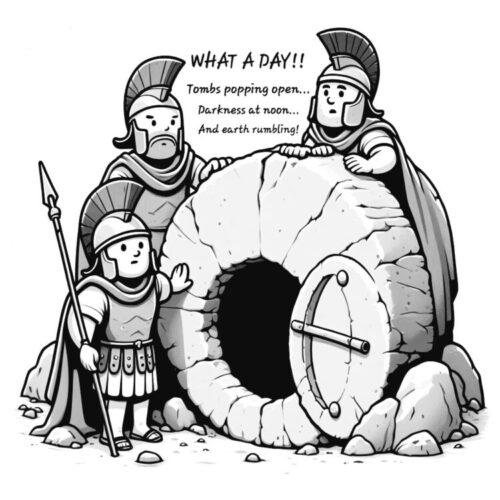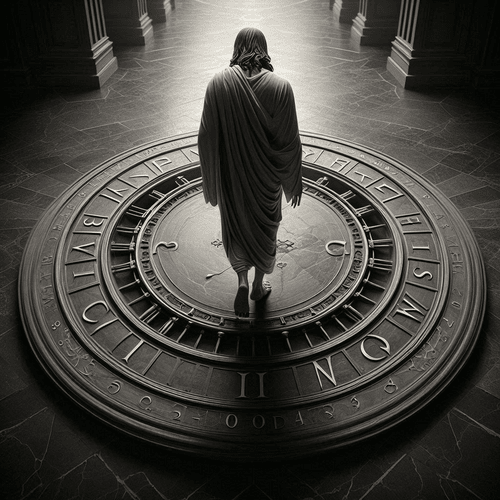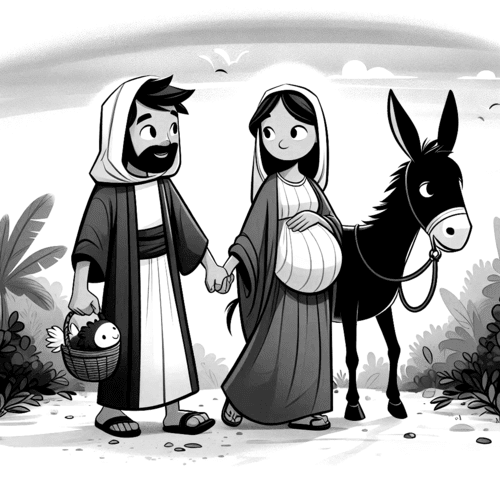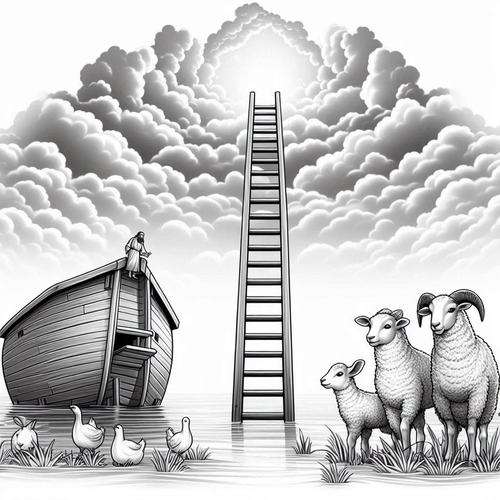Dead Men Rising: Exploring Matthew 27’s Mass Resurrection
In the precise moment of Christ’s death, a whole cluster of unprecedented events occurred (Matthew 27:51-53). Among them, Matthew’s gospel records tombs breaking open and “many holy people” rising from the dead after Jesus’ resurrection, appearing to many in the holy city. The events, often overshadowed by Christ’s own resurrection, carry profound meaning. While Scripture gives us only a brief glimpse of these remarkable moments, they offer us rich insights into the scope and power of Christ’s redemptive work…
THE HISTORICAL AND TEXTUAL CONTEXT
This mass resurrection occurred as part of a cluster of supernatural events surrounding Christ’s death.
- The Temple Veil Is Torn: The massive temple curtain separating the Holy of Holies tore from top to bottom. This symbolises direct access for the believer to God through Christ’s sacrifice. The supernatural event, happening at the precise moment of Jesus’ death, marks also the end of the old covenant system of temple worship. The direction of the tear—from top to bottom—emphasises it was an act of God, rather than human effort.
- The Earthquake: A powerful earthquake struck Jerusalem at Christ’s death, splitting rocks and opening tombs. The seismic event testified to creation itself responding to the death of its Creator. The physical upheaval mirrored the spiritual significance of what was taking place.
- Darkness Over the Land: This was darkness at the break of noon. For three hours during Christ’s crucifixion—from noon until 3 pm—darkness covered the land. The supernatural darkness symbolised God’s judgement and the cosmic significance of Christ’s death. It fulfilled prophetic expectations and demonstrated divine involvement in these events.
WHO WERE THESE RAISED SAINTS?
While Scripture doesn’t name these individuals, the description “holy people who had died” suggests they were faithful believers who had died before Christ’s coming. The Reformed view suggests these would have been those who’d trusted in God’s promises and looked forward to Christ’s coming, much like those described in Hebrews 11. Some suggest these were the recently dead believers—folks who’d be readily recognised when they turned up at their doorstep.
Their selection was not random but sovereignly determined by God to serve His purpose of witnessing to Christ’s victory. They were likely people who would have been recognised by the inhabitants of Jerusalem, making their testimony all the more powerful.
WHY WAS IT A TWO-STAGE EVENT?
Another question we wrestle with is this: why did the opening of tombs happen at Jesus’s death, and the mass resurrection occur three days later? The separation in time carries deep theological significance. This timing preserved Christ’s position as “firstborn from the dead” (Colossians 1:18). The delay demonstrated their resurrection was dependent on and flowed from His resurrection.
This two-stage process also beautifully illustrates how Christ’s death began the work that His resurrection would complete. The breaking of the tombs signifies the end of death’s reign, while the actual raising of the saints demonstrates the positive gift of new life.
THE AFTERMATH—WHAT HAPPENED TO THE SAINTS THEREAFTER?
Scripture is silent about what ultimately happened to the resurrected saints. Reformed theologians generally conclude the raised saints likely experienced a second death—much like Lazarus—having fulfilled their testimony to Christ’s victory over death. The view aligns with the biblical pattern where other resurrected individuals (remember Lazarus, the widow’s son, and Jairus’s daughter) returned to mortal life on being raised—rather than receiving their final glorified bodies. Their temporary restoration served God’s sovereign purpose of testifying to Christ’s power, while preserving the unique nature of Christ’s resurrection and the future hope of permanent resurrection at His return.
This view maintains both the historical reality of their resurrection while preserving the theological significance of Christ being the “the firstborn from the dead” (Colossians 1:18).
WHAT DOES IT ALL MEAN FOR US? THE THEOLOGICAL BIG PICTURE
- Christ’s Supreme Victory Over Death: The mass resurrection dramatically demonstrates Jesus didn’t just escape death personally—He conquered it completely and holds its keys. His victory extends beyond Himself to all who belong to Him, showing death’s power has been fundamentally, well and truly broken.
- The Unity of God’s Redemptive Plan: This event beautifully bridges the Old and New Testaments, showing Old Testament saints share in Christ’s victory just as New Testament believers do. The simultaneous raising of believers from different eras visibly demonstrates there is now one people of God, united in Christ’s resurrection power.
- The Physical Nature of Redemption: By raising actual bodies from real tombs, God affirms salvation isn’t just spiritual but involves the physical creation. The event reminds us Christianity isn’t about escaping the physical world but about ultimately redeeming and transforming it through Christ.
- Divine Sovereignty Over Time: The precise timing—tombs opening at death but saints rising after resurrection—shows God’s meticulous control over every detail of redemptive history. Even death and resurrection happen according to His careful orchestration. Neither too early nor too late.
- The Public Nature of God’s Testimony: The saints appeared to many in Jerusalem, demonstrating God’s redemptive acts aren’t private spiritual experiences but public historical events. Their appearances in the city validate God works in real history and geography, providing concrete witnesses to His power.
- The Firstfruits Promise: Just as these saints followed Christ in resurrection, they preview the great harvest of resurrection to come for all believers. Their rising serves as a guarantee that just as Christ raised them, He will surely raise all who belong to Him at His return.
- Creation’s Response to Redemption: The combination of earthquake, darkness, and resurrection shows Christ’s death and resurrection hold cosmic significance affecting all creation. This event previews the full renewal of creation itself, when death will be completely overcome and creation fully restored.
CONCLUSION: DEAD MEN RISING
The mass resurrection following Christ’s victory over death is a powerful testament to the completeness of His redemptive work. Far from being a mere historical curiosity, the event gives us confidence Christ’s victory extends to all His people, transcends time itself, and guarantees our own future resurrection. As we contemplate these saints who rose and testified to Christ’s power, we’re reminded our faith rests not on abstract promises but on demonstrated power—the same power that will one day call all believers from their graves. In this extraordinary moment, we see a preview of our own future, when Christ’s victory over death will be fully realised in the resurrection of all His people.
DEAD MEN RISING—RELATED FAQs
Why does only Matthew mention these events? Matthew, writing primarily to a Jewish audience, was particularly concerned with demonstrating Jesus as the fulfillment of Old Testament prophecies and expectations about resurrection. His inclusion of this event specifically connects to Jewish hopes about the Messianic age and the resurrection of the righteous, making it especially relevant to his intended readers. The other Gospel writers, under divine inspiration, focused on different aspects of Christ’s death and resurrection that served their distinct purposes.
- What is the significance of this event occurring during Passover? The timing during Passover connected Christ’s redemptive work to Israel’s great exodus from death to life. Just as the first Passover marked Israel’s deliverance from death and bondage, this mass resurrection demonstrated the greater exodus Christ accomplished through His death and resurrection. The feast time also meant Jerusalem was filled with pilgrims who would carry this testimony throughout the Jewish world.
- How long did these resurrected saints appear to people? Scripture doesn’t specify the duration of their appearances, maintaining a respectful silence on details beyond their basic testimony. From a Reformed perspective, their purpose was to testify to Christ’s resurrection power, so their appearances likely continued long enough to establish reliable witness but not so long as to distract from Christ’s unique resurrection.
Were these saints raised with glorified bodies like Christ’s? Given that Christ is the “firstfruits” of the final resurrection, these saints likely received temporarily restored natural bodies similar to Lazarus, rather than glorified bodies. Their resurrection served as a sign pointing to Christ’s victory rather than representing the final resurrection state that awaits believers at Christ’s return.
- What was the impact on the early church’s growth? These appearances would have provided powerful confirmation of the apostles’ preaching about Christ’s resurrection in Jerusalem. When Peter preached on Pentecost about the resurrection, many in his audience would have been aware of these resurrected saints, strengthening the credibility of the Christian message.
- Does this event relate to Christ’s “preaching to the spirits in prison” (1 Peter 3:19)? While some have connected these events, Reformed theology generally treats them as separate occurrences. The raised saints were likely recent Jewish believers whose testimony would be recognized in Jerusalem, rather than connecting to Christ’s proclamation of victory in the spiritual realm.
How does this event align with Jewish feast dates and customs? The timing aligned with both Passover and the Feast of Firstfruits, occurring during the season when Jews offered the first sheaf of harvest. This timing powerfully connected Christ’s role as “firstfruits” of resurrection with the agricultural symbolism of the Jewish calendar, demonstrating how He fulfilled these feast patterns. The fact that these saints appeared in Jerusalem during this major feast period ensured maximum impact for their testimony.
DEAD MEN RISING—OUR RELATED POSTS
Editor's Pick

The Christian Sabbath: Why Did Sunday Replace Saturday?
Consider this: God-fearing Jews who’d faithfully observed Saturday Sabbath for over a thousand years suddenly began gathering for worship on [...]
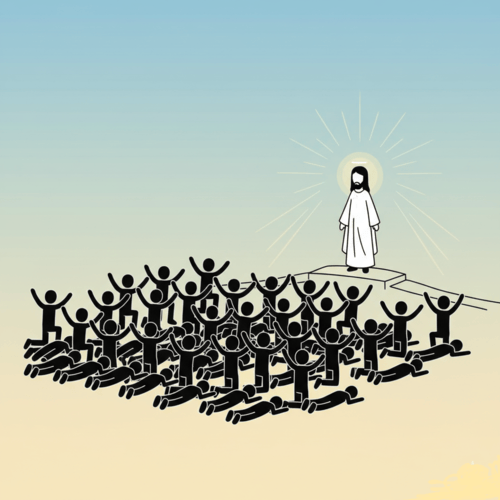
Did the Early Christians Worship Jesus? The Biblical Evidence
It was a startling transformation: Jewish fishermen who'd spent three years following this itinerant carpenter from Nazareth now begin to [...]

If Jesus is Messiah, Why Aren’t ALL Messianic Prophecies Fulfilled?
If Jesus is truly the Messiah, why hasn't world peace arrived? Why do Jews still face persecution? Why isn't the [...]

When Courage Fails: Will I Be Forgiven If I Deny Christ in Persecution?
The rooster crowed, and Peter remembered. In that devastating moment, the apostle realised he’d just done the unthinkable—three times he’d [...]

What Makes a Godly Dad? 5 Biblical Principles Fathers Need
Modern culture sends fathers mixed messages. Be strong but sensitive. Be involved but not overbearing. Lead but don’t dominate. With [...]

What Makes a Godly Mom? A Scripture-Backed Guide
In our culture’s confusion about gender roles and parenting, the timeless question remains: what makes a godly mother? While secular [...]

Paul’s Mandate for Men: Headship Or Servant Leadership? Or Both?
Modern Christianity has fallen into a trap. We've created an either/or battle between "headship" and "servant leadership," as if these [...]

Should We Stop Using Male Pronouns for God? Why Do We Say No?
A friend of ours arrived eagerly at his first theology class in seminary. But he quickly discovered something troubling: the [...]

Did Old Testament Law Force Women to Marry their Rapists?
**Editor’s Note: This post is part of our series, ‘Satan’s Lies: Common Deceptions in the Church Today’… Viral misinformation abounds [...]
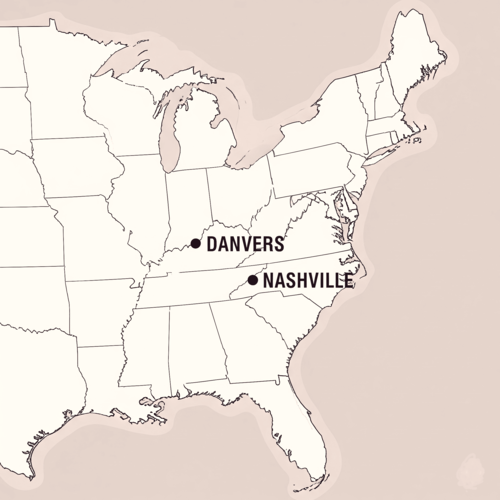
From Danvers To Nashville: Two Statements, One Biblical Vision
30 years separate the Danvers Statement on Biblical Manhood and Womanhood (1987) and the Nashville Statement on Human Sexuality (2017). [...]
SUPPORT US:
Feel the Holy Spirit's gentle nudge to partner with us?
Donate Online:
Account Name: TRUTHS TO DIE FOR FOUNDATION
Account Number: 10243565459
Bank IFSC: IDFB0043391
Bank Name: IDFC FIRST BANK


